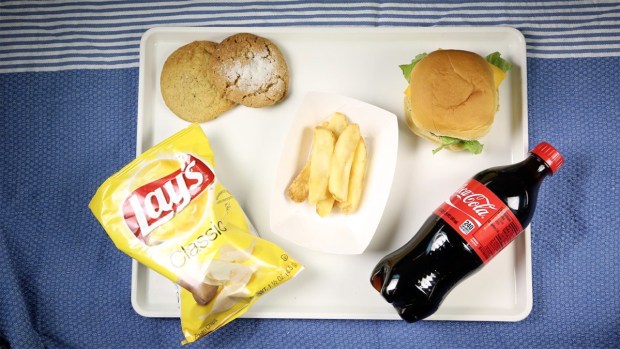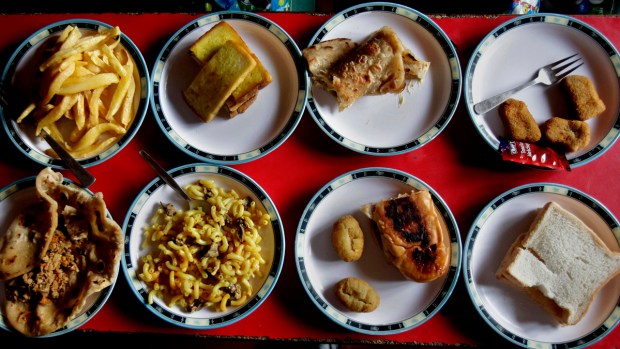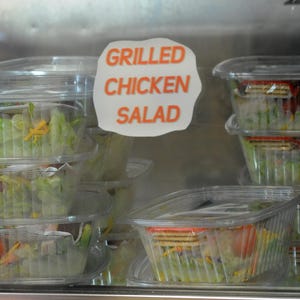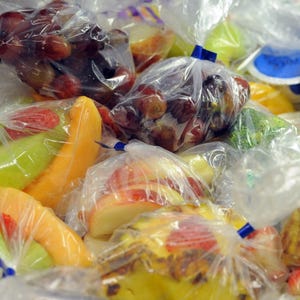No one ever confused school lunch with a gourmet meal. But you'd think
parents could count on their children getting safe, nutritious food.
When Primetime producers went on surprise inspections of school
cafeterias, however, they found stomach-turning conditions that parents
never get to see: dead rodents just feet from where food was being
prepared, roaches crawling along filthy floors, dishwashers that don't
clean children's trays, and food being kept at temperatures where
potentially dangerous bacteria can thrive.
Experts who track food safety in schools say such conditions can be
found across the country — and that they put children at risk. "Those
districts who continue to operate like this are surely going to have a
major food-borne illness at some point. It's almost a guarantee," said
food consultant Norm Greenberger, who has visited hundreds of school
cafeterias.
School Food Illnesses on the Rise
Schools have been feeding children lunch since the National School Lunch
Act of 1946. The idea was that nutritious meals would help children
grow and learn. But government figures show that over the past decade
there have been 300 outbreaks of food illness in schools, affecting
16,000 students — and that such incidents are rising by 10 percent a
year.
In 1996, bacteria in spaghetti served at five schools in Sacramento,
Calif., made 400 children sick. In 1998, 1,200 students in seven states
became ill after eating burritos from a plant in Chicago.
Also in 1998, 12 children became infected with E. coli bacteria that
health officials linked to beef tacos served at rural Finley Elementary
School in Washington state. One of the children, a 2-year-old girl who
doctors believe contracted the infection from a sibling or playmate, was
so seriously ill that doctors say she will need kidney transplants
before she turns 8.
Starting at the Source
Primetime started its school lunch investigation at the source: the
processing plants that supply meat to schools. The U.S. Department of
Agriculture, which administers the National School Lunch Program,
purchases enough food to feed 27 million children every day. The
department is also responsible for inspecting every meat plant that
supplies schools.
For the Primetime segment, a safety inspector agreed to take a hidden
camera to a plant that processes more than a million pounds of chicken
for schools each year. The inspector, who requested anonymity, found
several chickens with yellow sores indicating an infection under the
skin, as well as potentially hazardous fecal matter. The inspector also
found filth in machines that box chicken and processing equipment
dripping with chicken fat. Documents obtained by Primetime showed that
the plant had repeatedly failed tests for salmonella and inspectors say
they had demanded improvements, but, they said, the plant kept selling
chicken for consumption at schools.
When shown the video, Elsa Murano, the USDA's undersecretary for food
safety, said it was "upsetting to say the least." She said the
department has "revolutionized" its meat inspection system in the past
four or five years, toughening health regulations for plants that
process meat.
She confirmed that the USDA sometimes buys meat for the school lunch
program from plants that have had health violations in the past, but
only if the plants correct the problems "to our satisfaction." In the
Finley Elementary School case, the USDA had bought the contaminated beef
from a plant that had been cited for 171 critical violations in the
previous 18 months.
The USDA buys meat from the lowest bidder that passes government
standards, which can cause problems, according to food safety advocate
Caroline Smith Dewaal. "The plants that want to sell to the school lunch
program are frequently the plants with some of the worst records,
because they're the ones who can keep the meat cheap," said Dewaal, food
safety director for the Center for Science in the Public Interest.
Cockroaches in the Capital
Even if there are problems at a processing plant, food safety experts
say proper handling in school kitchens will kill potentially dangerous
bacteria.
But when Primetime accompanied health inspectors on visits to school
cafeterias, the inspectors found numerous problems. At Shaw Junior High
in Washington, D.C., inspector Ronnie Taylor found two dead rodents just
feet away from where workers were preparing pizza for 300 children.
Taylor also found cockroaches under a kitchen sink, and a moldy drain
that he believed was providing a source of food for the vermin. "The
mice, the roaches, will walk across this. It'll become attached to their
bodies and legs.... They'll walk across food contact surfaces and
tables that are used for prep and they'll contaminate those surfaces,"
said Taylor, who has been inspecting school cafeterias for 22 years,
adding, "This is a terrible situation.... I've never seen it this bad."
According to health experts, roaches can transmit salmonella and
dysentery, and rats can also carry disease. Taylor ordered the school to
immediately start having meals delivered.
When 14-year-old student Teanna Anderson was shown the conditions in the
kitchen, she was horrified. "We're humans. We're not animals. We
shouldn't have to eat around stuff like that," she said.
D.C. schools superintendent Paul Vance said he gives the district's
schools an overall "B" for food safety. But when shown what Primetime
found at Shaw, he said it was "horrific."
And when told that two weeks after the inspection the problems had not
been fixed, he promised that "consequences will follow." Ten days later,
he announced that he had placed Shaw's principal, along with four food
workers and the head custodian, on leave pending an internal
investigation. The conditions were cleaned up.
Mice in the Suburbs
Primetime also found health violations conditions at Julia Green
Elementary in a prosperous suburb of Nashville, Tenn. Inspector Ivone
Rodriguez came across one of the most frequent problems inspectors
encounter: hot food being kept at the wrong temperature. When she
measured turkey fritters, which should be kept warm at 140 degrees or
above, she found they were at just 123 degrees. "Leaving it at that
temperature for an extended period of time, bacteria can grow and
reproduce and then cause an illness," she said, before ordering the
cooks to rapidly reheat the fritters.
A test strip revealed that the school's dishwasher did not have any
chlorine, meaning it was not sanitizing the plates and removing germs.
The school was cited for mouse droppings and insects last spring, and
Rodriguez said the latest violations were just as critical.
At Eakin Elementary, also in a well-to-do Nashville suburb, food manager
Vanetta Donegan said that last year there so many mice in the kitchen
that staff kept a log of rodent sightings. "I'd be sitting at my desk
doing paperwork and here they go across the floor. And they'd sit there
and look at you like you was crazy, like, what are you doing in their
kitchen?," she said.
Nashville school administrators said they have taken care of many of the
problems at their schools — including the mice at Eakin — and are
working hard to clean up all their cafeterias.
Parents: Check Your Kids' Schools' Kitchen
The parents of the children who were sickened at Finley Elementary in
Washington state sued the school district. They won a $4.7 million
verdict against the school system, which denies the incident was its
fault and has appealed.
One of the sickened students, A.J. Almquist, who was 10 at the time,
remembers having nonstop vomiting and bloody diarrhea, and says he was
in the worst pain of his life. Since then, his parents have told him to
stay away from hot meals at school, and he sits through lunch with just a
bottle of water.
"I'm sending my children to school to get a nice hot meal, thinking I'm
doing the best thing for him.... And that's what almost killed him, was a
school lunch," said Gerri Almquist, A.J.'s mother.
The Almquists have some advice for other parents: When you visit your
children's school, don't just go to the classroom to see what they are
learning — make sure to go to the cafeteria, to see what they are
eating.






